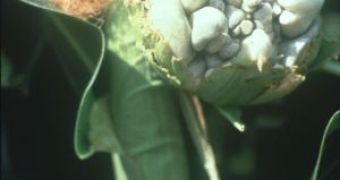The corn's smut ( Ustilago maydis ) is a parasite fungus of the maize which produces well known hideous and huge tumors on what should be maize cobs.
In Mexico, people consider these tumors a delicacy, but farmers in most other countries see them as a nuisance.
This fungus is not toxic, thus infected plants can be used as cattle fodder, but are not suitable for human consume.
People have tried for long to fight this parasite with no effective success.
An international team at the Max Planck Institute for Terrestrial Microbiology has analyzed smut's genome in order to find how it damages the plant.
Among the 7,000 genes found, some are implied in the life of the fungus at the expense of its host plant, without killing it, or trick its defense.
Some genes were located close to each other, forming clusters, thus they might have been involved in the same process. "If they hadn't been present in clusters, we would probably not have discovered them," says J?rg K?mper, at the Max Planck Institute for Terrestrial Microbiology.
"It's like a cornfield in which 200 cornflowers are growing. If they are scattered over the field, you don't notice them. But if they're close together, they are easy to spot."
The Max Planck's researchers focused on genes implied in infecting the plant.
The team experimentally removed one of the twelve gene clusters from the genome.
Four clusters proved essential in the infection.
One of the clusters clearly curbs smut's own aggressiveness: removing this gene cluster made the fungus to cause even greater damage to its host.
This makes sense, as Ustilago relies on the living plant in order to propagate.
That's why Ustilago maydis has only 33 enzymes dissolving plant cell wall compared with well over 100 enzymes of this type in fungi which simply eat their hosts.
Ustilago's attacks are not so severe like those of other fungal parasites, but it may be a model on combating others which are related (like rust fungi) and more difficult to study.
"Hopefully our findings on Ustilago maydis can be transferred to this group of fungi," says K?mper.
Researchers are on the way to clarify the functions of the proteins encoded by the gene clusters.
"Surprisingly, hardly any of these proteins resemble a known protein from a different organism," says Regine Kahmann, Director at the Max Planck Institute.
The proteins might form a biochemical camouflage in order to elude plant's defenses or they might actively suppress the defenses.

 14 DAY TRIAL //
14 DAY TRIAL //